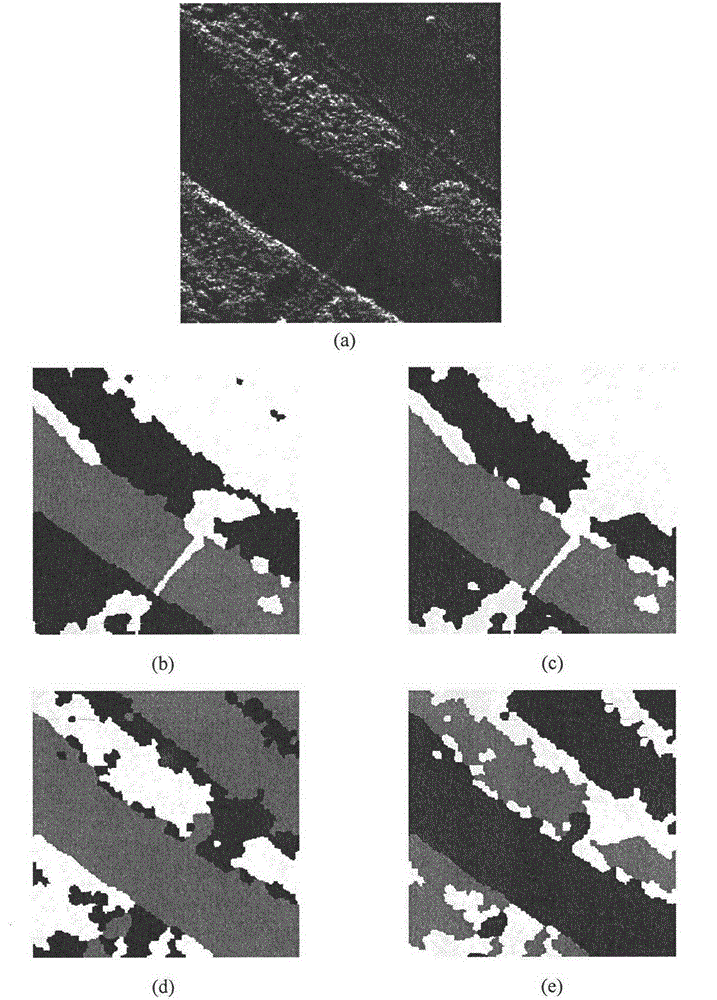Decomposition-Based Multi-target Remote Sensing Image Segmentation Method
A remote sensing image and multi-target technology, applied in the field of image processing, can solve problems such as single evaluation index, high computational complexity, and poor detail retention performance, and achieve the effect of improving accuracy and reducing computational complexity
- Summary
- Abstract
- Description
- Claims
- Application Information
AI Technical Summary
Problems solved by technology
Method used
Image
Examples
Embodiment 1
[0066] The present invention is a multi-target remote sensing image segmentation method based on decomposition, belongs to the technical field of image processing, and further relates to a segmentation method in the technical field of remote sensing image segmentation. The simulation of this example is carried out in the hardware environment of PentiumDual_CoreCPUE5200 with a main frequency of 2.3GHZ, a memory of 2GB, and a software environment of MATLABR2009a.
[0067] The invention is a multi-target remote sensing image segmentation method based on decomposition. Aiming at the shortcomings of the prior art such as single evaluation index, high computational complexity, and poor detail retention performance, the invention proposes a multi-target remote sensing image segmentation method based on decomposition. Image Segmentation Methods. In the method, the fusion feature is extracted as the data to be clustered to better preserve the image details; two complementary objective ...
Embodiment 2
[0109] The multi-target remote sensing image segmentation method based on decomposition is the same as embodiment 1. In order to possess practicability, the present invention is further described in detail as follows:
[0110] Wherein the further detailed description of image feature extraction in step 2 is as follows:
[0111] 2.1.1 The process of extracting texture feature vectors by using the gray level co-occurrence matrix method includes: firstly, the image to be processed is quantized into 16 gray levels, and then the angle between the line connecting two pixel points and the horizontal axis is 0° , 45°, 90° and 135°, respectively calculate the gray level co-occurrence matrix in the four directions according to the following formula:
[0112] P(i,j)=#{(x 1 ,y 1 ), (x 2 ,y 2 )∈M×N|f(x 1 ,y 1 ) = r, f(x 2 ,y 2 )=s}
[0113] Among them, P(i, j) is the element of the gray level co-occurrence matrix at the coordinate (i, j), # is the number of elements in the set {},...
Embodiment 3
[0136] The multi-target remote sensing image segmentation method based on decomposition is the same as embodiment 1-2, and the segmentation effect of the present invention can be further illustrated by the following experiments:
[0137] The experimental simulation environment is: PentiumDual_CoreCPUE5200 with a main frequency of 2.3GHz, a hardware environment with a memory of 2GB, and a software environment of MATLABR2009a.
[0138] figure 2 (a) is the optical remote sensing test image used in the simulation experiment. This optical remote sensing image data is part of the port map of Shelter Island in the San Diego area. There are two types of labels, one is land and the other is port. The image size is 256 ×256. Using the decomposition-based multi-target remote sensing image segmentation method of the present invention to figure 2 (a) Segmentation is performed.
[0139] In the experiment, AnEvolutionaryApproachtoMultiobjectiveClustering (MOCK), genetic algorithm cluste...
PUM
 Login to View More
Login to View More Abstract
Description
Claims
Application Information
 Login to View More
Login to View More - R&D
- Intellectual Property
- Life Sciences
- Materials
- Tech Scout
- Unparalleled Data Quality
- Higher Quality Content
- 60% Fewer Hallucinations
Browse by: Latest US Patents, China's latest patents, Technical Efficacy Thesaurus, Application Domain, Technology Topic, Popular Technical Reports.
© 2025 PatSnap. All rights reserved.Legal|Privacy policy|Modern Slavery Act Transparency Statement|Sitemap|About US| Contact US: help@patsnap.com



